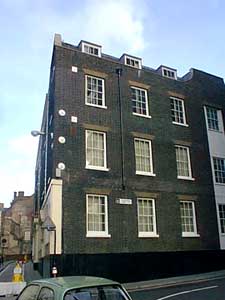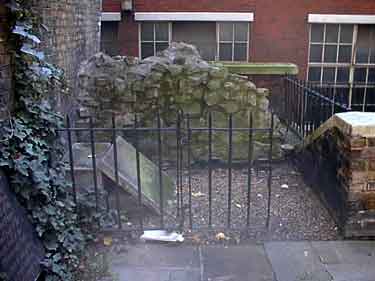|
|

Blackfriars Playhouse
Playhouse Yard, EC4
 A modern street sign and a fragment of an ancient stone wall are the only lasting reminders of a building that once housed one of three London theatres where Shakespeare trod the boards. A modern street sign and a fragment of an ancient stone wall are the only lasting reminders of a building that once housed one of three London theatres where Shakespeare trod the boards.
With no plaque and nothing unusual to draw the attention of passers by, the name Playhouse Yard is the only clue to the historical background of this area. Yet it is one of few remaining that can boast genuine links with England's greatest dramatist.
Seconds away from the frantically busy traffic intersection at Blackfrairs Bridge, Playhouse Yard seems almost deserted by comparison. An unremarkable street at first sight, it is worth exploring carefully. Within paces, it leads to an obscured churchyard and a little maze of alleys which would have been very familiar to Shakespeare when he lived and worked here at the end of the 16th century.
At that time, Playhouse Yard was part of a massive monastic complex which had been confiscated during the reformation. The monastery, which stretched from Shoe Lane off Fleet Street right down to the Thames at Puddle Dock, had belonged to the Dominicans who were known as the Black Friars because of their habit. The whole district retained this name and when the old refectory was turned into a theatre, it was naturally used to define its location.
Public playhouses were formally banned here but in 1577 an enterprising choirmaster managed to set up a private theatre in the refectory on the basis that his boy singers needed a place to practice. The theatre closed in 1584 but the building was bought twelve years later by one James Burbage, the son of a carpenter and travelling player, who intended to open the theatre to the public.
This plan came to nothing initially. Burbage died before the work was complete and the local residents anyway complained that a public playhouse would lower the tone of the neighbourhood. Burbage's son, Richard, converted the Blackfriars back into a private theatre in 1597 in order to placate them but by 1608 he was finally able to open it to the public and it was at this point that he went into partnership with Shakespeare and other actors in the company that they had formed.
The Blackfriars Theatre was big enough to hold between 600-700 people and Burbage's company, first called the Lord Chamberlain's Men and then the King's Men, would have performed many of the plays that Shakespeare had written for their use here and at their sister playhouse, the Globe on Bankside. The works of other writers were also presented here, amongst them Ben Johnson's Every Man in his Humour in which Shakespeare himself was an actor in 1598.
Unlike Bankside, Blackfriars was a fashionable residential area and Shakespeare bought a house a short walk away from the theatre in Ireland Yard. The house, which he later willed to his daughter Susannah, would have overlooked both St. Ann's church yard and another of the old monastery buildings, the Provincial's Hall. St. Ann's is long gone but a section of the monastery wall (photo below) can still be found in the part of its churchyard that remains in Ireland Yard.


St. Ann's churchyard is open all week during daylight hours.
 Blackfriars (District and Circle line) Blackfriars (District and Circle line)
Copyright © Jan Collie 2002
Published by permission of the author.
All rights reserved. No reproduction, copy or transmission of this publication may be made without written permission.
|
|